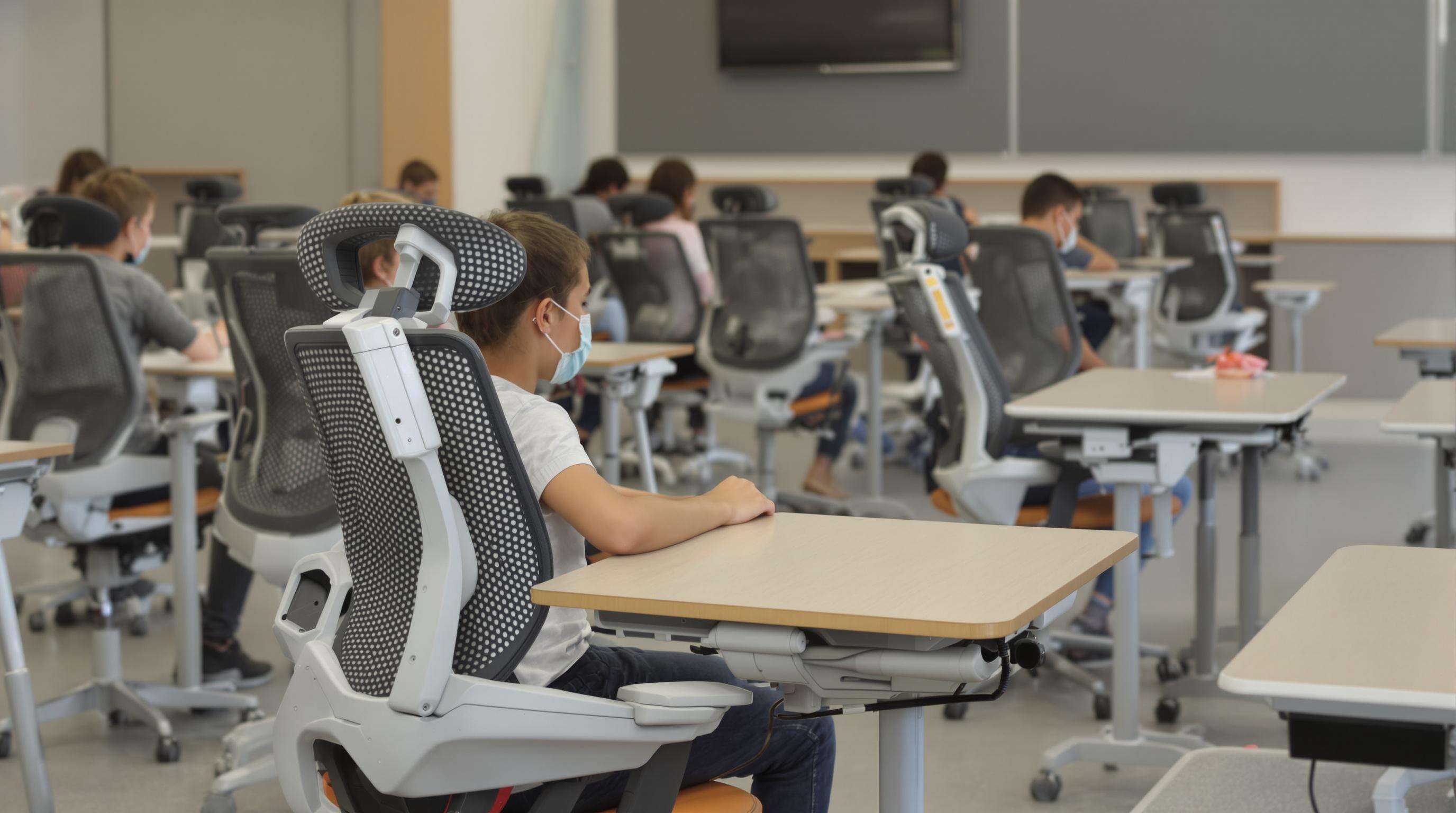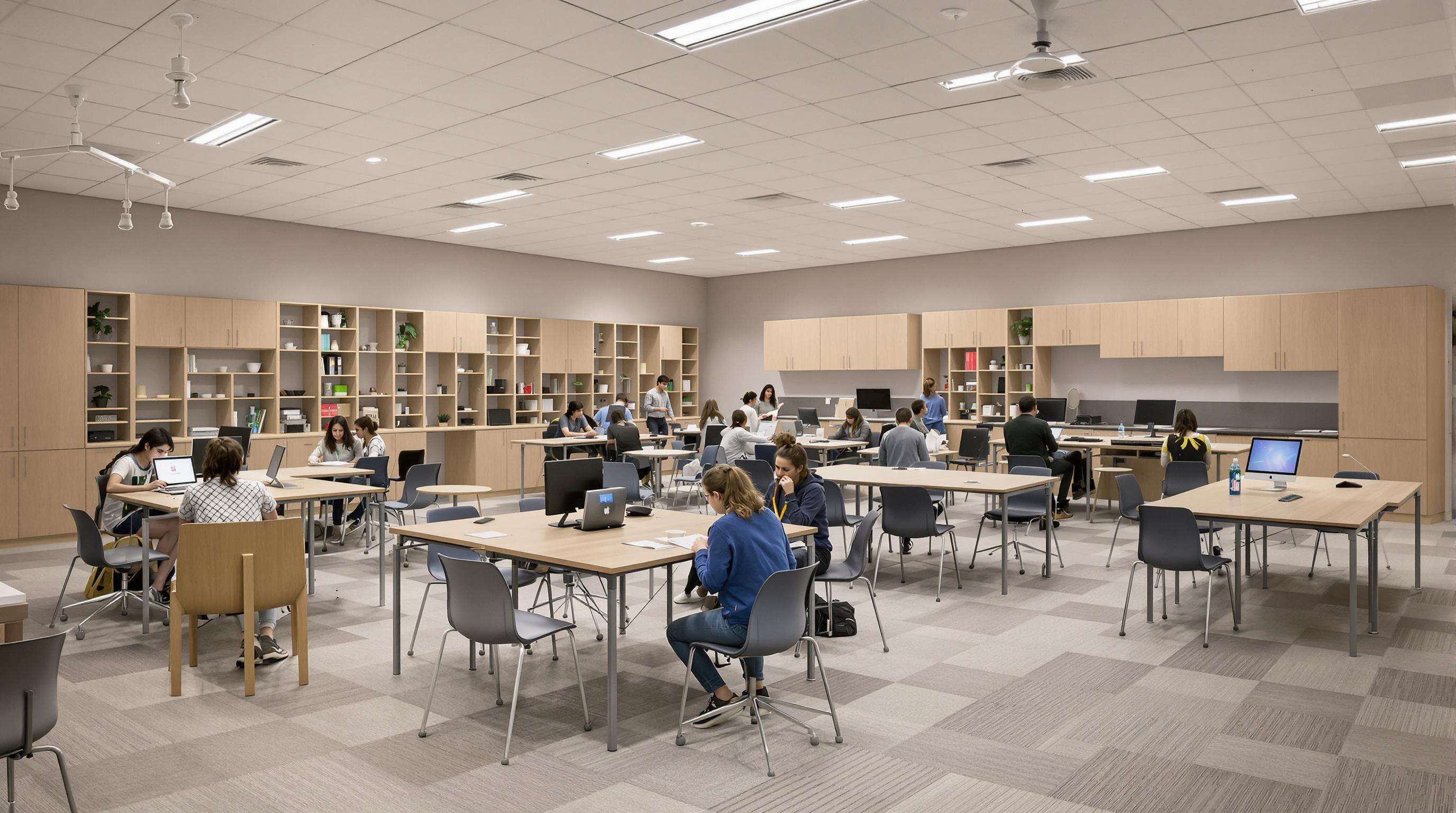مجموعات كراسي وطاولات الطلاب من أجل تعلم فعال
تصميم هندسي مريح في مجموعات كراسي الطاولات الدراسية للطلاب

فهم التصميم الهندسي لمفروشات الطلاب
تساعد مكاتب وكراسي الطلاب التي تتبع المبادئ الهندسية في الحفاظ على المحاذاة الصحيحة للجسم مع التكيف مع متطلبات كل شخص محددة، مما يدعم في النهاية الوضعية الصحيحة أثناء جلسات الدراسة. وبحسب الدراسات الحديثة المنشورة في مجلة Frontiers in Psychology في عام 2025، فإن الأطفال الذين يجلسون على مجموعات مفروشات مريحة هندسياً يعانون من تقليل بنسبة 32% في إجهاد الظهر، ويمكنهم التركيز لمدة أطول بنسبة 19% مقارنة بمن يستخدمون مفروشات مدرسية تقليدية. السر الحقيقي وراء هذه التحسينات يكمن في ثلاثة عناصر تصميمية أساسية:
| مميز | الفائدة الفسيولوجية | المواصفات الموصى بها |
|---|---|---|
| ارتفاع المقعد القابل للتعديل | يحفظ انحناء الركبة بزاوية 90° | 14"-20" نطاق |
| ظهر الكرسي مُشكّل | يدعم انحناء العمود الفقري القطني | 12"-14" تعديل عمودي |
| التحكم في عمق المقعد | تمنع الضغط على الدورة الدموية في الساقين | عمق 15-17 بوصة مع آلية الإمالة |
تستخدم النماذج الحديثة مواد شبكيّة تنفسية وتعديل متزامن لارتفاع المقعد والمقود، مما يسمح بملاءمة شخصية مع نمو الطلاب. وقد وجدت تجربة أُجريت في فصل دراسي عام 2024 أن 78٪ من المدرسين لاحظوا تقليلًا في التقلّب عندما استخدم الطلاب مقاعد ذات آليات إمالة ديناميكية تدعم الحركة الخفيفة دون المساس بالاستقرار.
حلول ملائمة لعمر الطالب تتضمن مقاعد وطاولات قابلة للتعديل
الدعم في النمو الجسدي من خلال أثاث قابل لتعديل الارتفاع
تحتاج الفصول الدراسية إلى أثاث يتكيف مع أجسام الطلاب المتغيرة. تشير الدراسات إلى أن 68٪ من المشكلات المتعلقة بالوضعية الجسدية لدى المراهقين تنشأ بسبب عدم ملاءمة الأثاث (تقرير الإرجمونكس في التعليم، 2023). تعالج مجموعات المقاعد والطاولات القابلة للتعديل من حيث الارتفاع هذه المشكلة من خلال توفير:
- قابلية تعديل ارتفاع المقعد من 3 إلى 12 بوصة للمواكبة النمو السريع
- مقياس عمق/عرض متناسب مُحاذاة مع نسب الورك إلى الركبة عبر الفئات العمرية
- دعاسات متكاملة لتجنب تأرجح الساقين، خاصة لدى الطلاب الأصغر سنًا
أظهرت تجربة أُجريت في مدرسة متوسطة بمنطقة فينيكس أن هذه المزايا خفضت من الإبلاغ عن عدم الراحة في الظهر بنسبة 41٪ خلال أيام الدراسة الكاملة مقارنة بالأثاث الثابت الارتفاع.
تصميم كراسي مكتب الطالب لتلبية احتياجات المرحلة الابتدائية والمتوسطة والثانوية
تتطلب المراحل التنموية حلولًا مخصصة للأثاث:
| المستوى الأكاديمي | نطاق ارتفاع المكتب | التركيز الرئيسي في التصميم |
|---|---|---|
| الأساسية | 22"–26" | الدقة، الحواف المستديرة |
| المدرسة الإعدادية | 24"–30" | أذرع ضبط النمو |
| المدرسة الثانوية | 27"–33" | معايير هندسة مختبرات الجامعات |
ت increasingly incorporate collegiate features مثل مناضد قابلة للتعديل بزاوية 15°، والتي تقلل إجهاد الرقبة بنسبة 33% خلال المحاضرات التي تستمر 90 دقيقة (مجلة علوم الوضعية، 2024).
دراسة حالة: تنفيذ أثاث مخصص حسب العمر في مدرسة ابتدائية وثانوية
مدرسة في وسط الولايات المتحدة الأمريكية استبدلت 12000 مقعد دراسي شهدت تحسناً ملحوظاً خلال 18 شهراً:
- الأساسية : انخفاض بنسبة 29% في شكاوى أولياء الأمور بشأن "التململ" بعد إدخال كراسي مزودة بدعامات للأقدام
- المدرسة الإعدادية : زيادة بنسبة 18% في درجات الاختبارات القياسية في الفصول التي تحتوي على طاولات قابلة لتعديل الارتفاع
- المدرسة الثانوية : زيادة بمقدار 22 دقيقة في متوسط فترات العمل المنظّمة بعد التنفيذ
وأشار مدير المرافق في المدرسة قائلاً: "لقد سمح لنا نهجنا التدريجي بتحقيق ترقيات اقتصادية مع التركيز على الدعم التشريحي في كل مرحلة من مراحل النمو."
تصميم فصول مرنة لدعم التعلم الفردي والجماعي

تحقيق التوازن بين التركيز الفردي والعمل الجماعي من خلال تصميم المقاعد
يؤثر تخطيط الفصل الدراسي بشكل كبير على كفاءة التعلم. البيئات التي تجمع بين محطات العمل الفردية ومناطق التعاون تقلل من التشتت بنسبة 34٪ وترفع التفاعل بين الزملاء بنسبة 28٪. تدعم التكوينات مثل الترتيب على شكل حرف U التعليم المركّز والانتقال بسهولة إلى المناقشات الجماعية، في حين تشجع التخطيطات المتعرجة الحركة والانخراط في أنشطة تعليمية متنوعة.
أثاث قابل للحركة والتعديل لدعم بيئات الفصل الدراسي الديناميكية
تُحسّن الكراسي الخفيفة الوزن مع عجلات قفل متحركة بشكل كبير من قابلية التنقل في الفصول الدراسية هذه الأيام. كما أن الطاولات نفسها رائعة للغاية - فهي مصممة بشكل متعدد الوظائف على شكل شبه منحرف مما يسمح للمعلمين بتبديل الترتيب بسهولة من العمل الجماعي الصغير (عادة ما يتراوح بين 4 إلى 6 طلاب) إلى ترتيب يشمل الفصل بأكمله خلال أقل من دقيقتين. ولا ننسى أيضًا الطاولات القابلة لتعديل الارتفاع التي تدعم كل أنواع أدوات التعلم الرقمية وتتناسب مع وضعيات الجلوس والوقوف. وبحسب دراسة حديثة نُشرت في مجلة البيئة التعليمية السنة الماضية، لاحظ 7 من أصل 10 معلمين تحسنًا في معدل إنجاز المهام عندما كانت فصولهم مجهزة بهذا النوع من المرونة المدمجة.
تحسين المساحة والتخزين وإمكانات سطح الطاولة للتعلم الهجين
تكتشف المدارس التي تتبنى نماذج التعلم الهجينة أن الأثاث المتعدد الاستخدامات يُحدث فرقاً حقيقياً في ديناميكية الفصول الدراسية. حلول التخزين مثل حاملات المستندات الرأسية والمحافظات تحت المقاعد تقلل من الفوضى بشكل كبير مقارنة مع الإعدادات القديمة التي رأيناها من قبل. بعض الدراسات تشير إلى انخفاض بنحو 40% في الفوضى، مما يساعد على الحفاظ على التركيز خلال الدروس. أصبحت الطاولات التي تفتح لتظهر لوحات بيضاء على جانبيها شائعة في العديد من الجامعات. هذه المكاتب تعمل بمثابة المكاتب العادية، ولكنها تتحول إلى مراكز لمناقشة الأفكار كلما كان ذلك ضروريًا، ويقول المعلمون عن تحسن بنسبة 20 إلى 25٪ تقريبًا في كيفية معالجة الطلاب للمشاكل معًا في صفوف العلوم والرياض ما هو مفيد حقاً هو تلك الموانئ المدمجة لشحن في قاعدة كل مكتب. لم يعد يتعين على الطلاب التنافس من أجل التسوق عند التبديل بين العمل بمفردهم ومشاريع الجماعة، وهو شيء كان يسبب تأخيرًا وإحباطًا طوال اليوم.
تأثير تصميم كرسي الطالب على نتائج التعلم
الأدلة من الدراسات: كيف تؤثر الأثاث على راحة الطالب وقدرته على التركيز
تُظهر الدراسات باستمرار أن الأثاث المريح يُحدث فرقًا حقيقيًا في مستوى التركيز والرفاهية العامة. وبحسب بحث نُشر في مجلة BMC Public Health في عام 2023، فإن الطلاب الذين استخدموا مكاتب قابلة للتعديل في الارتفاع كانوا أكثر انخراطًا في أعمالهم وأفادوا بمستوى أفضل في التركيز مع الحفاظ في الوقت نفسه على الأداء الأكاديمي الجيد. كما كشف بحث آخر نُشر في مجلة Frontiers of Psychology عام 2025 عن نتائج مثيرة للاهتمام حول كراسي العمل المريحة. فقد أظهرت هذه المقاعد المصممة خصيصًا تقليلًا في إجهاد العضلات بنسبة تصل إلى 37 بالمئة. والأكثر إثارة للاهتمام؟ تمكن الطلاب الجالسون عليها من التركيز خلال الاختبارات لمدة أطول بنسبة 42 بالمئة مقارنة بأقرانهم الذين استخدموا كراسي مكتبية عادية. هذا الأمر منطقي عندما تفكر في مدى إمكانية أن يشتت الأثاث غير المريح تركيز الشخص الذي يحاول التعلم.
ربط المقاعد المريحة من الناحية الجسدية بالانخراط الذهني والأداء الأكاديمي
عندما يكون الطلاب مرتاحين من الناحية الجسدية، فإن أدمغتهم تعمل بشكل أفضل لأن الجسم يعمل بشكل عام بكفاءة أكبر. تشير الأبحاث إلى أن الكراسي التي توفر دعمًا مناسبًا للظهر السفلي يمكن أن تزيد تدفق الدم إلى الدماغ بنسبة تتراوح بين 15 إلى 18 في المئة، مما يبدو أنه يساعد الأطفال على حل المشكلات بشكل أسرع في فصول العلوم والتكنولوجيا والهندسة والرياضيات. وأفادت المدارس التي نفذت حلولًا لتقديم مقاعد مكتبية مريحة للطلاب ودمجت أيضًا طرقًا تعليمية قائمة على الحركة، بأنها شهدت تحسنًا بنسبة تتراوح بين 12 إلى 14 في المئة في نتائج اختبارات الرياضيات وفهم النصوص القرائية بعد مرور ثلاث سنوات دراسية فقط. تشير هذه النتائج إلى وجود قيمة حقيقية في الاستثمار في الأثاث المدرسي الذي يناسب حقًا أجسام الطلاب النامية.
أسئلة شائعة
ما هو الأثاث المريح للطلاب؟
تم تصميم الأثاث المريح وفقًا لمبادئ علم الوضعية بحيث يدعم الوضعية الصحيحة والراحة الجسدية، وهو يتناسب مع نمو الطلاب واحتياجاتهم الخاصة، ويتميز بخصائص مثل قابلية تعديل الارتفاع ودعم الظهر.
لماذا التصميم المريح مهم لمقاعد ومكاتب الطلاب؟
يساعد التصميم المريح في تقليل الإجهاد الجسدي، وتحسين التركيز، ودعم أداء أكاديمي أفضل من خلال محاذاة الجسم بشكل صحيح أثناء جلسات الدراسة.
كيف تؤثر الخصائص القابلة للتعديل في أثاث الطلاب على نتائج التعلم؟
تسمح الخصائص القابلة للتعديل بإجراء تخصيصات وفقًا لمتطلبات كل طالب الجسدية، مما يعزز الراحة، ويقلل من التشتت، ويزيد التركيز والانخراط.
ما الفوائد التي أظهرتها الدراسات الناتجة عن استخدام أثاث طلابي مريح؟
أظهرت الدراسات تحسنًا في التركيز، وتقليلًا في إجهاد الظهر، وزيادة في الانتباه خلال الاختبارات، وتحسين تدفق الدم إلى الدماغ، وكلها تساهم في تحسين نتائج التعلم.
كيف يدعم أثاث الفصل الدراسي المرِن عملية التعلم؟
الأثاث المرن يسمح بتحويل سهل بين أوضاع التعلم الفردي والجماعي، ويشجع الحركة، ويقلل من الفوضى، مما يحسن إتمام المهام بشكل عام ويزيد من مستوى الانخراط.


